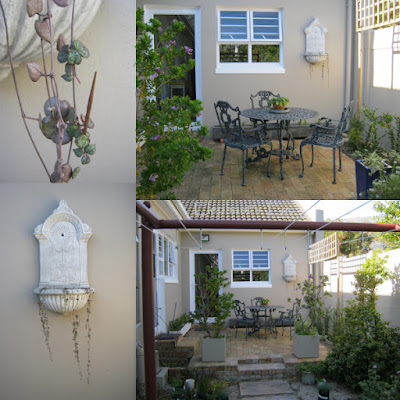Our False Bay garden in September
By Diana Studer
- gardening for biodiversity
in Cape Town, South Africa
 |
| East patio with wall planter and Ceropegia |
Blue pot as a focal point replaces the lime tree.
 |
| Tall blue pot on the East Patio |
Cornish Stripe at the washing pergola. Blue (and purple) and white is crisp and fresh. Inspired by my mother's stories of a childhood in Cornwall and my mug with wide blue and white 'Cornish stripes'. (I first thought willow pattern, vaguely eastern, deep red pergola reminds me of Japanese torii = bird abode!)
 |
| Newly planted at Cornish Stripe |
Leaves are dark, Prunus nigra and tuberous begonia. Or light, Liriope, variegated Felicia and Plectranthus madagascariensis.
 |
| Adenandra, Felicia Babiana, begonia |
Instead of gRRRumbling when my wet washing lands in the sand, I'm planting fragrant either indigenous or herbs. Pelargoniums and lavender. Our edible garden - lemon, banana, olive, peach seedlings. Flowers for salad.
 |
| Lemon tree is slowly pruning to a good shape (one last lemon to whack unwary gardeners) On the kitchen windowsill a row of lemons Yellow Clivia with slipper orchid |
Skip the work in progress at Woodland Walk, to the fiddlewood which is turning orange ahead of the summer. When its leaves fall, I need to do some serious pruning. Yellow Clivia battled in Porterville, got devoured by snails. I was enjoying the first luscious flower when the wind snapped it off. Luckily I found it in time for the vase. Summer Gold and Spring Promise. Delighted that the indigenous Buddleja opened a gentle mauve and wafts thru the house Is there honey still for tea. Wild orchid from Porterville is blooming happy.
 |
| Lachenalia, Dombeya wild orchid Clivia, fiddlewood, Buddleja |
As the Melianthus blooms I see that flower, the rusty Inspire, and the painted gate work together in the Rose Courtyard. Lime tree is sending out new branches and laden with gazillions of tiny fruit and happy bees.
 |
| Lime tree Melianthus |
The Ungardener had just one paving slab left over (nicely calculated!), sliced to fit and added as a more comfortable step up to the Karoo Koppie. In the Terraforce is a volunteer yellow daisy (renostergousblom) Arctotis acaulis - also covered in happy bees and beetles.
 |
| Pregnant onion, Cotyledon, Euphorbia volunteer yellow daisy renostergousblom |
An ivory Californian poppy appeared amongst the bronzed orange my mother loved. The Flanders red poppies have one with a delicate white lacy edge to its petals. Wide flat terracotta pot I've planted with cuttings to echo the Karoo Koppie.
 |
| Californian poppy, Kalanchoe Flanders poppy |
Inspired by Beth at Plant Postings' Lessons Learned I have broken up the Planted Here list where even I got lost. Seven pages / tabs let me list what I planted when with a few before and after pictures. The joy of a blog being virtual is that I can fuel my OCD impulses and keep tweaking till it sits right. What is that plant? Tick. Where did I put this plant? Tick. The links are listed at the top of Planted Here and also distributed thru this post.
Wildflower Wednesday for Gail at Clay and Limestone. This September the foreign flowers are Prunus nigra, herbs, begonia, lemon and lime, Kalanchoe, fiddlewood and poppies.
End of Month View for Helen the Patient Gardener
We went to a talk by Jenny Cullinan of Ujubee on our wild bees.
Capensis endemic bees with our endemic plants and birds. The only animal able to clone itself (if they lose their queen).
Fire asparagus blooms 2 weeks!! after fire to feed the bees.
Propolis can withstand temperatures of 100C, and behind their propolis wall the bees survive.
Scout bees monitor flower buds and prepare a nursery to use those flowers.
Specialist bees harvest wax and resin (which plants use to protect themselves) for propolis.
A bee can sense thru her feet if she's too late and someone has already harvested the nectar from that flower.
Bees battle cold corners in the square hives we force them into. A natural round shape of wood or clay would suit them better.
Prompted to observe I see carpenter bees on the Septemberbossie, and on the lime flowers bees so tiny I almost can't see them.
Best plant for bees is perennial basil (or herbs like borage) or indigenous.
To avoid the neonic contamination find an organic nursery.
Jenny is hoping to find oil bees - with long front legs, who harvest oil, not nectar, from disas.
(Any errors are mine)
 |
| Across False Bay to the Hottentots Holland mountains in July |
New header is a July walk on the promenade beyond our beach and looking across False Bay.
I invite you to join us at Elephant's Eye on False Bay. Please subscribe as you prefer
- Email via Feedburner,
or Feedly,
or Bloglovin,
or Facebook
Pictures by Diana Studer
of Elephant's Eye on False Bay
(If you mouse over teal blue text, it turns seaweed red
Those are my links.
To read or leave comments, either click the word Comments below,
or click this post's title)

what a beautiful visit I had here today,, you have created such a lovely oasis, it tickles all our senses, such a beautiful blend woven so well,
ReplyDeleteYour view of False Bay is so beautiful! It reminds me to get to one of the lakes here before the cold weather sets in. That's a great idea to set up a "planted here" list! I need to do something like that. I also enjoyed all the crisp, bright blue elements you've added to your garden and your Cornish stripe. And of course, the information about the bees is always so helpful. Thanks for joining in the meme, Diana. Have a wonderful week!
ReplyDeleteHi Diana! Your garden is looking good. Everything is so well balanced: colours, forms ... I have to say that the allusion to the ever so beautiful Japanese language got me right where it should.
ReplyDeleteThe Inspire sign is perfect for your false bay garden. BRAVO and thanks for enabling us to have a look at your beautiful garden.
Arlette
Dear Diana,
ReplyDeleteyour garden is taking shape!
I noticed that your Ceropegia is incubating seeds. Mine has never done this, I wonder why?
Have a nice day
Elke
perhaps it is missing the suitable pollinator?
Deletehttp://www.theguardian.com/lifeandstyle/2013/feb/02/alys-fowler-houseplants
DeleteAbsolutely wish I had another life because I'd do more gardening. Thank you for all the inspiration!
ReplyDeleteAs always, I enjoyed the progress being made in your home with beautiful, new and fresh elements. I especially love the cobalt blue pot, it's height giving the focus you want in your garden. The notes about bees are very interesting. I had no idea that perennial basil (or borage) was something that bees wanted more than other things. I always do have basil in the yard, and now I'll add to it with a perennial variety. Thanks.
ReplyDeleteYour new gardens are 'wonderful'. You've done a lot and it's all lovely.
ReplyDeleteFlowerLady
So many good things to enjoy in this post - colours, shapes, ideas. I particularly like the blue pot which reminds me of the planters in the Jardin Majorelle, Marrakesh.
ReplyDeletethank you. That's a garden I know only from virtual blog visits.
DeleteA lot to take in, I think I will have to return to this post. One thing I noticed and liked a lot was how you have enclosed area with high (placed high not tall) trellis in the first images and a beam (pergola) seems so simple but it does arrest the eye - clever.
ReplyDeletehttp://eefalsebay.blogspot.co.za/2014/12/christmas-garden-on-false-bay.html
DeleteThat was the result of some heated argument, after the 'green coffin' invasive trees came down. We wanted to screen various windows. I suggested the trellis. In places we've added a second overlapping layer. It allows light and the breeze thru but does gives some seclusion. I have climbers making their first twirls up the posts.
So very pretty!
ReplyDeleteIt is so wonderful to see your gardens heading into spring as ours fade with the start of fall. xo Laura
ReplyDeleteThe east patio is lovely! I also went to visit a bee-keeping friend a few weeks ago. Those bees are fascinating creatures.
ReplyDeletelittle and often, I prune the 2 Septemberbossies and coax the Australian brush cherry to a quarter obelix.
Deleteyou've done such a lot - the love and enthusiasm shows. That view is divine. I keep meaning to ask why is it called False Bay? Great idea to plant scented plants under the washing. If the washing doesn't fall down accidentally, you could deliberately drape it over the plants. Very interesting info about bees. There's a wonderful novel about bees I read a while ago: The Bees by Laline Paull.
ReplyDeletedisappointed sailors who had lost their way to Table Bay and Cape Town
Deletewho found themselves in False Bay by mistake
Lots of pretty flower pictures here, but I'm especially drawn to the understated look of the Ceropegia spilling from the wall planter.
ReplyDeleteThose blue pots at the beginning of the posting today are very nice. In Guatemala last week I came across many many places using white pots of the same form. I like that form. One last comment - love the final photo of the bay. Reminds me of here on Lake Michigan - except I can not see the other side of the lake here - it is 75 miles across at this point - more like an ocean. Jack
ReplyDeleteOur False Bay is 18.6 miles or 30 kilometres across its widest stretch.
DeleteThat pot shape IS good, it lifts the plants up where I can see them, is not unstable in the wind, and shows off the vibrant colour.
Wonderfull garden gorgeous flowers, greeting from Belgium.
ReplyDeleteI think my favorite spot is that East Patio...really beautiful and looks like I am gazing at a magazine. The color and shape of the blue pot is also incredible in the garden!
ReplyDeleteCornish Blue and White striped kitchenware is still being made and is still popular today.
ReplyDeleteI like how your new garden is developing, so many beautiful flowers and love your tall blue pot.
ah fascinating ... been Googling Cornishware.
DeleteThe colour is called e-blue, electric blue.
Since 1924. Inspired by Cornwall's blue skies and foaming waves.
My solitary mug needs company!
this Pauline?
Deletehttp://www.leadupthegardenpath.com/about/
Sadly there is no blog link from your comment
I love your east patio; it looks like a wonderful place to spend time (and the blue of that planter is sublime!). -Jean
ReplyDeleteThe beautiful blue of false bay: was it the inspiration for your fabulous blue pot? Interesting facts about bees.Who would know bees did not like square hives!
ReplyDeleteonly now you mention it do I see the blue Cornish sky echoed in False Bay, and the pots.
Delete"The Ungardener" always gets a laugh from me! Looking good...the scene across False Bay is amazing, like there's not a care in the world. I have a client who lives part-time in Del Mar, California...proabbly much like your area...they want unusual plants nobody else has...Cotyledon is going to be one. If I have to drive to get that one, too.
ReplyDeleteIf our forecast El Nino / wet / snowy / cool / terrible / etc winter comes true, I need to get some Mexican Gold Poppy seeds to grow out. Like the California you have, just a yellow subspecies.
I know Town Mouse in California grows various Cotyledon - so it is available.
DeleteWe have a couple of Caifornian poppies coming thru in ivory and softest yellow.